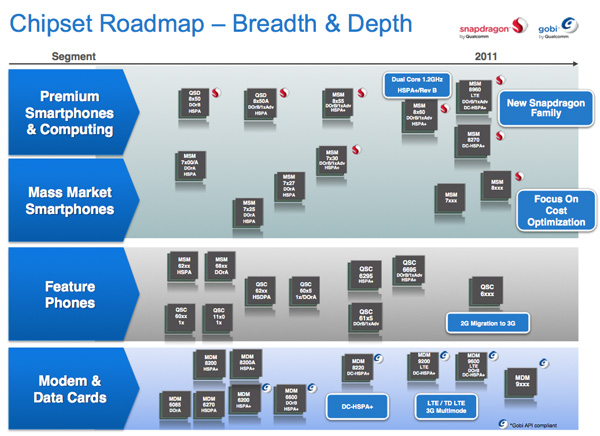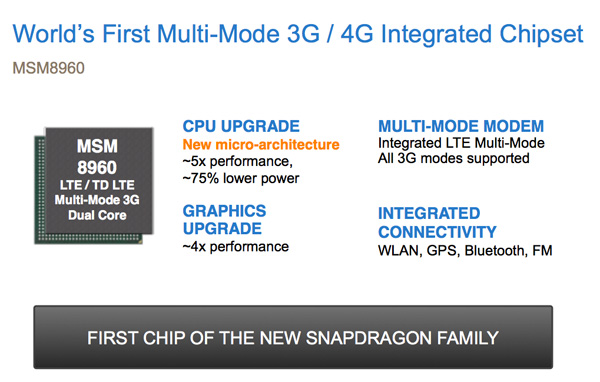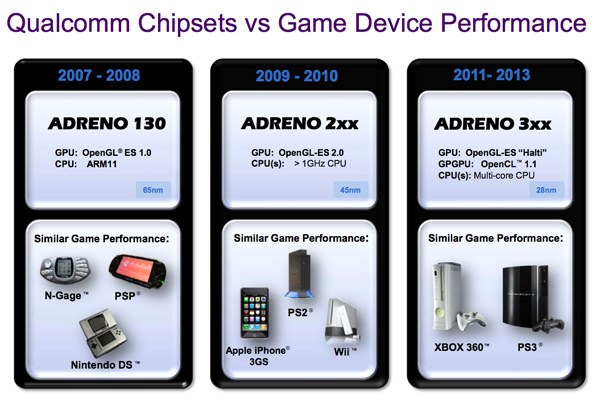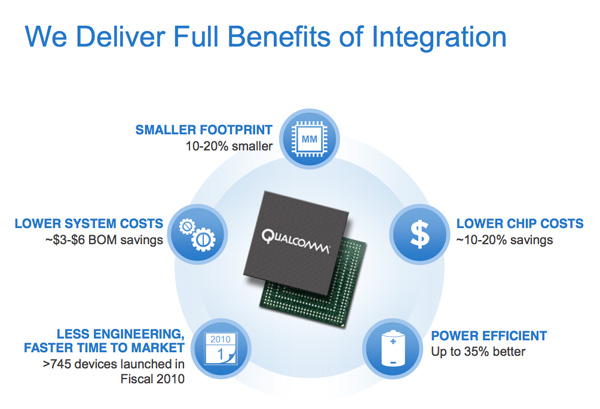Qualcomm Reveals Next-Gen Snapdragon MSM8960: 28nm, dual-core, 5x Performance Improvement
by Anand Lal Shimpi on November 17, 2010 11:00 PM EST- Posted in
- Smartphones
- Snapdragon
- Qualcomm
- MSM8960
- Adreno
- Mobile
- SoCs
Earlier today Qualcomm briefed analysts on its Snapdragon SoC roadmap. The current Snapdragon is available in both 65nm and 45nm versions integrating a single Scorpion CPU core running at up to 1GHz and an Adreno 200 or 205 GPU (respectively). Snapdragon was the SoC of choice for many Android phones over the past year and a half, not to mention the only SoC available in Windows Phone 7 devices.
In the coming months we’ll see the first dual-core Cortex A9 based NVIDIA Tegra 2 SoCs ship in devices. Sometime next year we’ll see A9 based OMAP4 SoCs in smartphones as well. So what does Qualcomm have in store for us over the next few years?
First we have the MSM8260 and 8660 SoCs. These are based on Qualcomm’s current generation technologies: integrating two Scorpion cores and an Adreno 205 GPU on a single 45nm die. The 8260 features HSPA+ support, while the 8660 supports HSPA+, CDMA2000 and 1xEV-DO Rev. B. These two dual-core SoCs will run at 1.2GHz. We should see a GPU upgrade here as well.
The 8x60 SoCs started sampling over the summer and we should expect to see them in high end smartphones sometime in 2011 at the earliest.
More exciting however is what comes next. Today’s disclosures included further details for the next-generation Snapdragon SoC built on a 28nm process. The first member of the next-gen Snapdragon family is the Qualcomm MSM8960 SoC.
Inside the MSM8960 are two next-generation processor cores, presumably out-of-order as Qualcomm is promising 5x the performance of the original Snapdragon chip (2x for the move to dual cores and the rest due to OoO, larger caches and other architectural tweaks perhaps?). Qualcomm isn’t disclosing clock speed at this time.
Power consumption is said to be 75% lower, however that seems very aggressive compared to what we have today. It’s unclear if Qualcomm is talking about active or idle power, or what version of Snapdragon it is comparing to (65nm or 45nm).
On the GPU side Qualcomm is making significant performance claims as well. The MSM8960 is set to offer a ~4x improvement in graphics performance. Again, Qualcomm wasn’t specific about what the reference point was. If it’s compared to the Adreno 200, that would imply a doubling of the GPU performance we have today.
Qualcomm has separately announced that the Adreno 3xx GPU would be used in SoCs from 2011 - 2013 on a 28nm process. This appears to be the GPU family used in the next-generation Snapdragon. Even more interesting is Qualcomm stating that Adreno 3xx will have performance similar to the Xbox 360/PS3.
If that’s indeed the level of graphics performance we’ll see in the next 3 years, being able to play Xbox 360 titles on Windows Phone 8 may not be too far fetched.
The 8960 continues to be a single chip solution with integrated modem, supporting all 3G modes as well as LTE. The MSM8960 will begin sampling in 2011, meaning we likely won’t see smartphones based on it until 2012.




















48 Comments
View All Comments
DanNeely - Thursday, November 18, 2010 - link
I suspect this is like an article posted on Arstechnica(?) a month or two back with some vendor claiming their new mobile GPU would have the same polygon (vertex?) capabilities as the PS3. What they weren't saying is that the polygon count on GPUs barely increased over the 4 generations from the geforce 5000 to 200, while total performance roughly doubled each time. The PS3's GPU is a 78xx variant which means that at best the true GPU capability is likely to be 4x less.It could be larger if they're playing games with the numbers. I don't recall the details but ATI and nVidia's poloygon numbers differed by about 3x for a comparable level of performance.
DanNeely - Thursday, November 18, 2010 - link
Also do you really think the iPhone 3GS and the Wii have equivalent GPU capabilities? I smell a rat here.nbjknk - Thursday, November 25, 2010 - link
Dear customers, thank you for your support of our company.Here, there's good news to tell you: The company recently
launched a number of new fashion items! ! Fashionable
and welcome everyone to come buy. If necessary, please
plut:==== http://www.vipshops.org ======
==== http://www.vipshops.org ======
==== http://www.vipshops.org ======
blandead - Wednesday, November 17, 2010 - link
OoO ... OpenCl 1.1 GPGPU support.. so they claim 5x Performance because the processor is going to dual-core and it's out of order. I wonder how fast AMD fusion will be then when it comes out late 2010. Maybe when everyone moves to 28nm even x86 will be within same power envelope. I wonder who will end up with faster product since everyone has some kind of CPU/GPU combination. Yay for 28nm!ricmoore1 - Thursday, November 18, 2010 - link
Snapdragon's CPU is already OOO.metafor - Thursday, November 18, 2010 - link
Not fully. It can do "some" instructions OoO, which could mean anything.jeffbui - Thursday, November 18, 2010 - link
I'm curious why Intel isn't competing in this market. They have the tools, manufacturing, and engineering prowess to make better processors than all their competitors.Minion4Hire - Thursday, November 18, 2010 - link
They ARE competing in this market. Moorestown ring a bell?http://www.anandtech.com/show/3696/intel-unveils-m...
Thermogenic - Thursday, November 18, 2010 - link
It might be because Qualcomm has such a strong patent portfolio that intel would have to pay a pretty hefty premium to include the 3G and LTE technologies, to the point they wouldn't really be competitive any longer.Intel could have a better CPU/GPU combination, but if you still need to have a separate chip for the cell phone functions, many vendors will likely stick with Qualcomm's simplified solution - system on a chip!
metafor - Thursday, November 18, 2010 - link
Many vendors only supply the App processor without a baseband and do very well. TI's OMAP for example, is "just" a CPU/GPU/DSP combo but it gives the current Snapdragon a run for its money.The problem with Intel is that for the past 30+ years, they've been chasing performance in their process technology as well as their design team philosophy.
Now all of a sudden, a market where you absolute cannot go above a 500mW limit has presented itself and -- even for Intel -- it'll take a while to transition to that.
Their 32nm process is impressive for performance, but even their "LP" line is well behind TSMC's LP line in terms of power -- both idle and switching. They may be faster, but in a mobile devices, 1GHz at 30mW idle and 500mW peak is far better than 2GHz at 200mW idle and 4W peak.
The thing holding Intel back is both their design (Atom) and process. But Intel being Intel, I wouldn't discount them. We're talking about the guys who could throw out the Pentium 4, then transition back to a more conservative design, without ever losing profit.